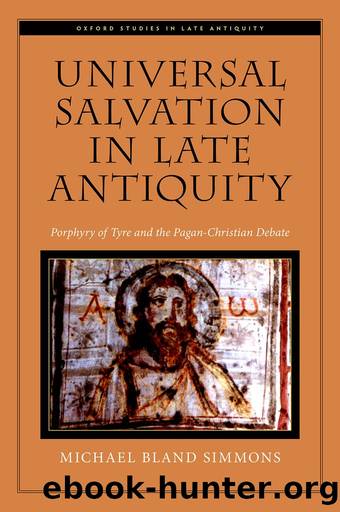Universal Salvation in Late Antiquity: Porphyry of Tyre and the Pagan-Christian Debate by Michael Bland Simmons

Author:Michael Bland Simmons
Language: eng
Format: epub
Publisher: Oxford University Press
Published: 2015-07-15T00:00:00+00:00
CHAPTER 1
1. See Jurado (2006): 81f., Test. X (= Lib., or. 18.178 [cf. Soc., HE III.23], comparing the polemical arguments of Porphyry and Julian; 87, Test. XXI (=Aug., Civ. Dei XIX.22; XXII.44: “a most learned philosopher”); ibid., Test. XXI (=Aug., Civ. Dei VIII.12: Porphyry listed among the very famous Platonic philosophers); ibid., Test. XXI (=Aug., Civ. Dei VII.25: “famous philosopher”); 89, Test. XXVIII (=6T Smith, p. 12) (=David in Porph., Isag. Proem., 92.2–6: Porphyry acknowledged by Pythian oracle for his great knowledge); 87, Test XXI (=Aug., Serm. 142.6: “great philosopher”); ibid., Test. XXI (=Aug., Retract. II.57; Ep. 102); Test. XXIIb (=Cyril Alex., Contra Iulianum I); Eunapius, Vit. Phil. 457 (LCL: Wright): “But Porphyry, like a chain of Hermes let down to mortals, by reason of his many-sided culture expounded all subjects so as to be clear and easy of comprehension.” Cf. also Eus., PE 3.7, 13; 9.1; 10.1. For negative comments, all from Christians, see Jurado (2006): 88, Test. XXIII (=Theodoret, Affect. II.3, 4, 10); Ibid., 87, Test. XXIIb (=Cyril Alex., Contra Iulianum I); Eus. PE 1.9; 4.6 (“friend of the demons”); 4.14 (“the oracle-monger”); 10.9 (“bitterest enemy” of the Christians); Aug., Serm. 241.7; Civ. Dei XIX.22, 23; Retract. II.57; Ep. 102.2, 8. On Augustine’s admiration for Porphyry, see Hoffman (1994): 17; for Eunapius, see Matthews (1996).
2. See Simmons (2002): 90–105; for the cultural background see Nilsson (1964) & (1969): pagan believer; de Labriolle (1929): 385–440; (1934): a controversialist; Raeder (1942): a scientific theologian; den Boer (1954) & (1973a): a historian (cf. Hansen [1967]); Jerphagnon (1990): a pagan evangelist (cf. Paschoud [1990]: 572); on Porphyry’s method of biblical exegesis see the appropriate works by Beatrice below. P. Brown (1967): 91 calls Porphyry the first systematic theologian in the history of thought. See also Meredith (1980); Nock (1960): 134; Dodds (1951): 286f.; Evangeliou (1997): 181; Lloyd (1967): 411–2; den Boer (1974): 203 goes too far to say that Porphyry was the precursor of the nineteenth-century Tübingen school of biblical higher criticism. For the cultural background to Porphyry see the excellent essays in Brunschwig, Lloyd, and Pellegrin, eds. (2000); and cf. Cilento (1968).
3. Bidez (1913); cf. Lamberton (1983): 4: “We have no reason to think that Porphyry was an original thinker; in fact, the evidence of all his surviving works tends to indicate just the opposite.”
4. P. Hadot (1968). Cf. Lévy (2004): 695 n. 64; Madec (1970). For the broader intellectual context see Hadot (1998); and the pertinent entries in Hammond and Scullard, eds. (1978).
5. See P. Hadot (1960a): 244: “. . . ce grand adversaire des chrétiens est une des figures les plus énigmatiques de la fin de l’antiquité…”; and Chadwick (1999): 68 on Porphyry’s being among the most influential third-century writers. Adcock, Charlesworth, and Baynes, eds. (Repr. 1981) is useful for the general historical and cultural context.
6. See de Labriolle (1929): 386: “. . . le plus redoubtable adversaire que le christianisme ait recontré durant les premiers siècles.”
7. See A. Smith (2010). For the general background see (e.g.) Chamoux (2003); Siorvanes (1998); Brown (1982); and Vaganay (1908–50).
Download
This site does not store any files on its server. We only index and link to content provided by other sites. Please contact the content providers to delete copyright contents if any and email us, we'll remove relevant links or contents immediately.
| Africa | Americas |
| Arctic & Antarctica | Asia |
| Australia & Oceania | Europe |
| Middle East | Russia |
| United States | World |
| Ancient Civilizations | Military |
| Historical Study & Educational Resources |
Mythos (2019 Re-Issue) by Stephen Fry(1197)
Alexander the Great by Robin Lane Fox(1182)
Antigone Rising: The Subversive Power of the Ancient Myths by Helen Morales(949)
On Sparta (Penguin Classics) by Plutarch(929)
The Classical World: An Epic History From Homer to Hadrian by Robin Lane Fox(890)
The Last Days of Socrates by Plato & Christopher Rowe & Plato(889)
Persian Fire by Tom Holland(832)
Cicero by Anthony Everitt(785)
The Athenian Constitution (Classics) by Aristotle(773)
The Greek World(702)
Antigone Rising by Helen Morales(662)
The Eudemian Ethics (Oxford World's Classics) by Kenny Anthony(648)
The Riddle of the Labyrinth(634)
The Story of the Greeks (Yesterday's Classics) by Guerber H. A(623)
Lords of the Sea: The Epic Story of the Athenian Navy and the Birth of Democracy by John R. Hale(620)
Guide to Greece by Pausanias(611)
The End of the Bronze Age by Robert Drews;(596)
The Homeric Hymns (Penguin Classics) by Homer(579)
Astrology and Religion Among the Greeks and Romans by Cumont Franz(576)
